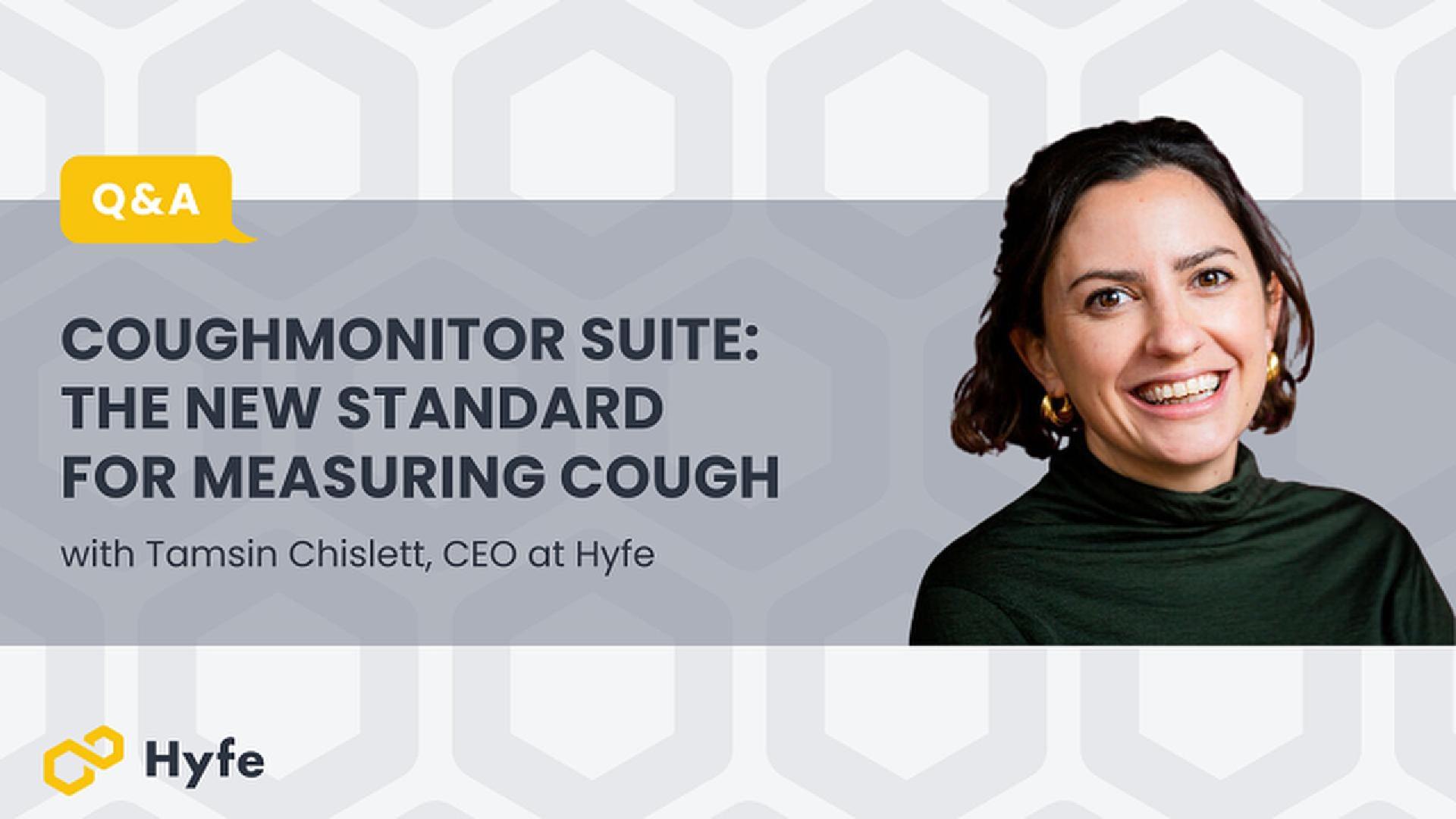
Q: Why does chronic cough need a digital therapeutic approach, and why now?
Reid: Cough treatment is far behind other areas of medicine. In the U.S., the FDA has not approved a new cough medication since 1958. Until recently, we also lacked the ability to measure cough accurately, which made it hard to develop or regulate effective treatments.
Now that Hyfe can monitor cough continuously over hours, days, and weeks, we can support the development of digital therapeutics that respond to what patients actually experience. Millions of people live with chronic cough, especially cough hypersensitivity. Since the most effective treatment is behavioral, now is the right time to digitize and scale that approach.
Watch the full interview here or scroll down to continue reading
Q: What makes Hyfe’s DTx successful in treating chronic cough?
Reid: There are three key elements. First, we start with a proven treatment: Behavioral Cough Suppression Therapy, or BCST. It is especially effective for unexplained or refractory chronic cough.
Second, we deliver that treatment in an engaging, easy-to-use app. We want users to feel supported and motivated, not like they are taking something unpleasant.
Third, we include a personalized feedback loop that uses real-time data from both app usage and cough monitoring. This allows us to track adherence, measure impact, and help users stay on track with their therapy.
Q: Is Hyfe’s DTx more scalable than traditional BCST?
Reid: Yes, significantly. There are only around 200 speech-language pathologists in the U.S. currently delivering BCST, and in most other countries, the number is even smaller. That means most people who could benefit from BCST simply do not have access to it.
By digitizing BCST and making it available through app stores, whether by prescription or over the counter, we can make this valuable therapy available to many more people.
Q: How is Hyfe translating the effectiveness of in-person BCST into a digital format?
Reid: We are working closely with two leading experts in BCST, Dr. Laurie Slovarp and Dr. Jane Salois. Their expertise has helped us solve a key challenge: how to teach people that they have the ability to manage their cough if they understand it, recognize the urge to cough, and learn to manage their triggers.
Their clinical experience has been foundational to designing a digital therapeutic that empowers people to take control of their symptoms, and we are thrilled to be collaborating with them.
Q: Can you walk us through the evidence that supports BCST’s effectiveness?
Reid: BCST has been tested in 15 clinical trials, including several high-quality randomized controlled trials. One study showed a 41 percent reduction in cough frequency, which is greater than any available drug except for centrally acting opioids. Those are not suitable for long-term use, so BCST represents a far more sustainable option.
In addition, more than 80 percent of patients report that BCST has been effective for their cough, which is a very high success rate.
Q: And beyond in-person care, has BCST been shown to work in virtual settings too?
Reid: Yes. Recent research by Dr. Slovarp and Dr. Salois shows that BCST works very well when delivered remotely, such as over Zoom. It has a major impact on how patients perceive their cough in three key areas: physiological impact, psychological well-being, and social functioning.
These dimensions are especially important because people with chronic cough often suffer emotionally and socially, not just physically. BCST helps address all of that.
Q: Can you tell us more about Hyfe's current DTx partnerships?
Reid: Our first commercial partnership is with Kyorin Pharmaceutical, a 100-year-old pharmaceutical company in Japan. We have been working with them to bring a fully localized version of our chronic cough DTx to the Japanese market.
Kyorin brings deep relationships with pulmonologists and ENT specialists. We bring the digital therapeutic platform. It is a strong partnership that combines clinical expertise with technology and user engagement.
Q: How does Hyfe ensure the DTx fits into clinical workflows?
Reid: From the very beginning, we design the product to integrate into existing clinical workflows. We do not want to create something doctors have to add on as an extra task. Instead, we aim to make the DTx a natural part of how they already care for patients.
That means the product looks a little different in each health system. For example, in Japan we are conducting in-depth interviews with clinicians to understand their workflows and how our app can fit in seamlessly.
Q: Could you share any specific examples of this in your work with Kyorin?
Reid: One story that really stayed with us came from a woman in Japan who had chronic cough but no underlying disease. She worked in an open-plan office and eventually left the job she loved because she was embarrassed to be coughing around colleagues.
She was afraid others saw her as contagious, even though she was not. Now she works alone in a basement, isolated from the work community she once loved. That story highlights what is at stake.
Chronic cough may not be life-threatening, but it can be life-altering. We believe a digital therapeutic can help people like her regain confidence and connection.
Q: How do you see cough DTx fitting into the current cough treatment landscape?
Reid: Today, our DTx can be used as a standalone treatment, especially when other options have failed. But there is also great potential for it to be used in combination with therapies for chronic respiratory conditions like COPD or asthma.
While BCST does not treat those diseases directly, many people with COPD or asthma also experience cough hypersensitivity. Our DTx can help address that specific problem, improving quality of life even when the primary disease is well-managed.
Q: Where do you see a cough DTx being most useful and effective?
Reid: We see opportunity in several areas. First, pharma companies building portfolios of digital products could integrate a cough DTx. Second, respiratory-focused pharma might use it alongside existing medications.
Outside of pharma, high-volume retail clinics can use digital therapeutics to deliver quick and effective care. And large employers in the U.S. may offer tools like ours through their health plans to improve access and lower healthcare costs.
Q: As we wrap up, what’s your outlook for the future of digital health?
Reid: There is still some skepticism about when digital therapeutics will become mainstream, but we believe it is not far off. Countries like the U.S., Germany, and Japan have regulatory frameworks in place to support DTx, and those are gaining traction.
Because regulated product development takes time, the time to plan is now. We are not talking about something 10 or 15 years away. We are close.
There has not been a “killer app” yet, but one is coming. And when it does, digital therapeutics will be a standard part of the tools and treatments doctors rely on.
Our latest news
Lorem ipsum dolor sit amet, consectetur adipiscing elit. Non eget pharetra nibh mi, neque, purus.




